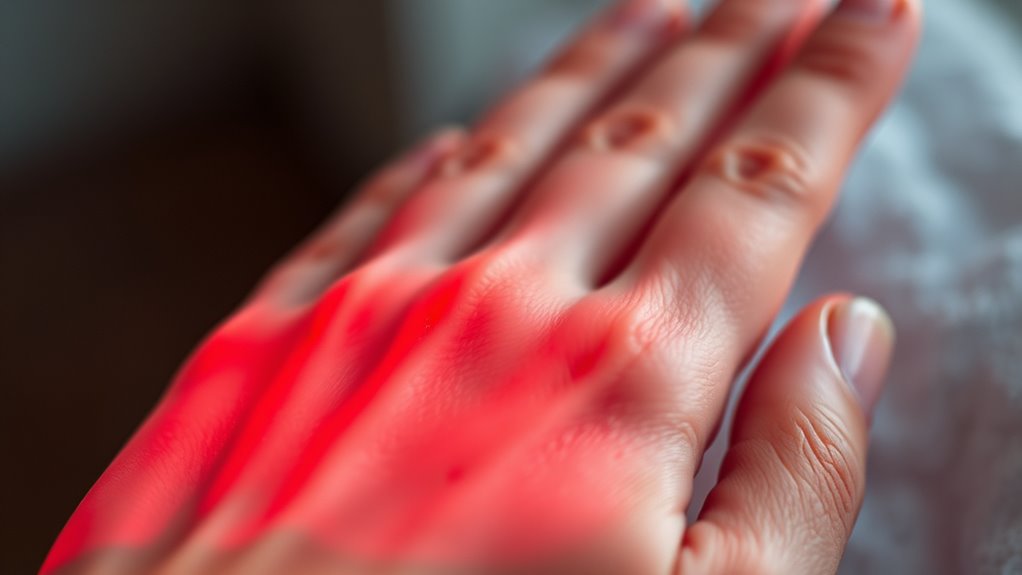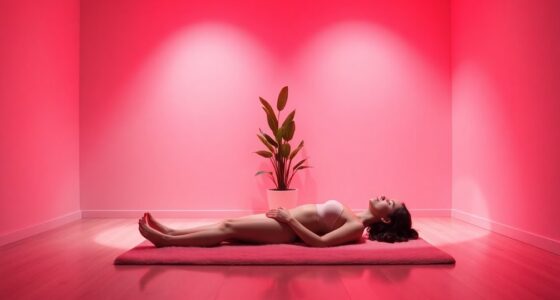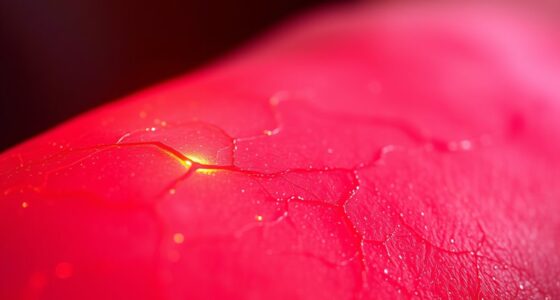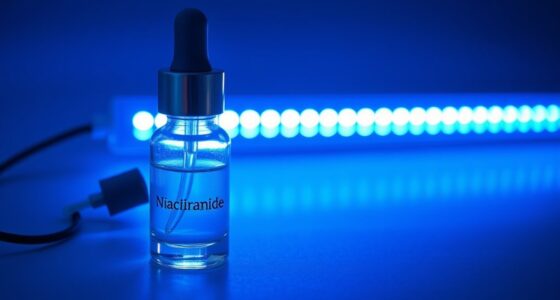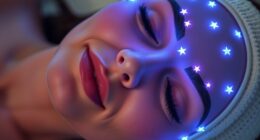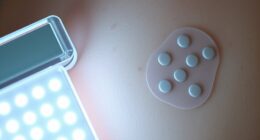If you have sensitive skin, you can still benefit from red light therapy by using gentle, carefully chosen devices designed for delicate skin. Start with short sessions of 5 to 10 minutes and use the lowest effective dose, gradually increasing as your skin adjusts. safeguard your eyes and avoid harsh skincare products afterward. Paying attention to how your skin responds helps ensure safe, effective results. Keep exploring for more tips on using red light therapy safely and comfortably.
Key Takeaways
- Use devices designed for sensitive skin and follow manufacturer instructions carefully.
- Start with short sessions (5-10 minutes) at the lowest setting, gradually increasing as tolerated.
- Perform a patch test to check for reactions before full treatment.
- Protect your eyes during sessions and avoid harsh skincare products afterward.
- Monitor skin response, and stop if irritation or redness occurs, consulting a dermatologist if needed.
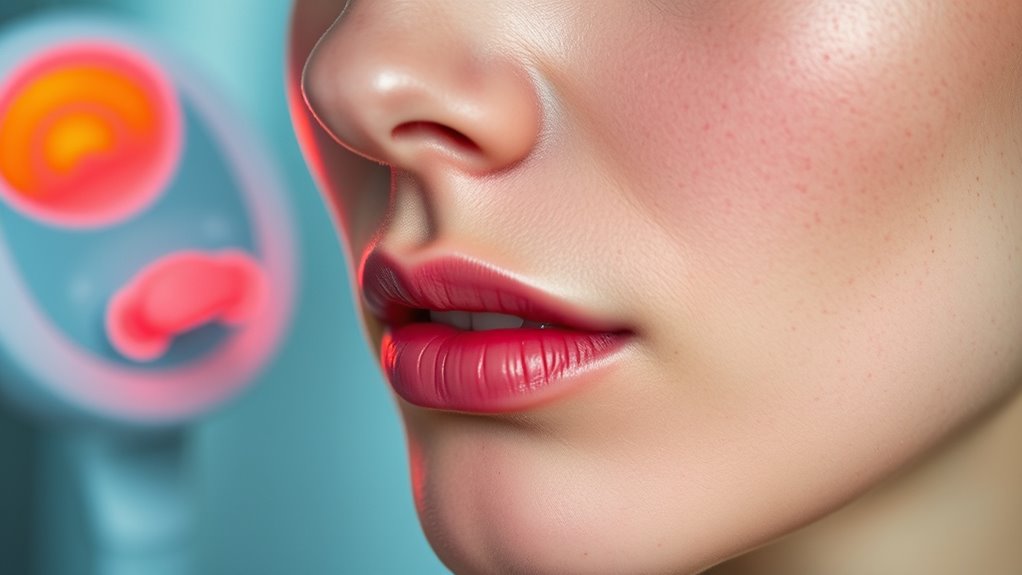
Have you ever wondered if red light therapy is safe for sensitive skin? It’s a common concern, especially when you’re cautious about trying new skincare treatments. The good news is that red light therapy is generally gentle and non-invasive, making it a suitable option for many with sensitive skin. However, it’s important to understand how to use it properly to avoid any irritation or adverse reactions. When you start, opt for devices designed specifically for facial use or sensitive skin, as these often have adjustable settings and softer wavelengths. Always read the manufacturer’s instructions carefully. Using the lowest effective dose initially allows your skin to adjust gradually, reducing the risk of redness or discomfort. If you notice any irritation, stop using the device immediately and consult a dermatologist. It’s also wise to perform a patch test before full application. Apply the light to a small, discreet area of your skin and wait at least 24 hours to see if any adverse reaction occurs. This step helps you determine whether your skin tolerates the therapy well. Keep in mind that sensitive skin can react differently depending on various factors like environmental conditions, skincare products, or even stress levels. So, be mindful of any external irritants and avoid using red light therapy when your skin feels particularly reactive or inflamed. When using the device, make sure your skin is clean and free of heavy creams or oils, which can sometimes interfere with light absorption or cause breakouts. Use gentle, fragrance-free cleansers beforehand to prepare your skin properly. It’s best to start with shorter sessions, around 5 to 10 minutes, and gradually increase the duration as your skin gets accustomed. Consistency is key, but never sacrifice comfort for longer sessions if your skin starts to feel sensitive or irritated. Remember to protect your eyes during treatment by wearing appropriate eye shields or closing your eyes, especially if the device emits bright or intense light. After treatment, avoid harsh skincare products or active ingredients like retinoids or acids for at least a few hours, as your skin may be temporarily more sensitive. Staying hydrated and applying soothing, fragrance-free moisturizers can help calm your skin post-treatment. It’s also helpful to be aware of skin sensitivities and external factors, as these can influence how your skin reacts to treatments. Overall, red light therapy can be a safe and effective addition to your skincare routine if you approach it gently and listen to your skin’s signals. With proper precautions, you can harness its benefits without compromising your skin’s sensitivity.
Frequently Asked Questions
Can Red Light Therapy Worsen Sensitive Skin Conditions?
Red light therapy can sometimes worsen sensitive skin conditions if you don’t use it properly. You might experience increased redness, irritation, or discomfort, especially if your skin reacts strongly to light. To prevent this, start with shorter sessions, use gentle settings, and monitor your skin’s response. If you notice worsening symptoms, stop treatment and consult a dermatologist. Proper precautions help guarantee safe, effective use without aggravating your sensitive skin.
How Often Should Sensitive Skin Undergo Red Light Treatments?
You should start with gentle sessions twice a week, like a soft drizzle nurturing your skin’s delicate garden. Observe how your skin responds, and if it stays calm, slowly increase treatments to three times weekly. Always listen to your skin’s whispers—if redness or irritation appear, ease off. Consistency and patience help your skin adapt without feeling overwhelmed, letting red light therapy become a gentle hug rather than a harsh storm.
Are There Specific Red Light Wavelengths Suitable for Sensitive Skin?
Yes, specific red light wavelengths are better suited for sensitive skin. Look for devices that emit wavelengths between 620-670 nanometers, as these are gentler and less likely to cause irritation. Avoid higher wavelengths that penetrate deeper and may trigger sensitivity. Always start with shorter sessions, monitor your skin’s response, and consult a dermatologist if you notice any discomfort. Using the right wavelength helps maximize benefits while minimizing risks.
What Skincare Ingredients Should Be Avoided Before Red Light Therapy?
You should avoid skincare ingredients like retinoids, alpha hydroxy acids (AHAs), beta hydroxy acids (BHAs), and benzoyl peroxide before red light therapy. These can increase your skin’s sensitivity, causing irritation or redness during treatment. Instead, opt for gentle, hydrating products that soothe your skin. Wait at least 24 hours after applying strong actives before your session to minimize any risk of adverse reactions.
Is Red Light Therapy Safe for People With Eczema or Rosacea?
Yes, red light therapy is generally safe for people with eczema or rosacea, but you should consult your dermatologist first. It can help reduce inflammation and improve skin healing. However, since your skin is sensitive, start with short sessions and low intensity to see how your skin responds. Always patch test before full treatment and avoid any areas that are actively irritated or inflamed to prevent worsening symptoms.
Conclusion
So, who knew that a gentle red light could be your skin’s best friend—yet somehow still make it feel like a delicate flower? It’s almost funny how something so soothing can require such careful attention. Just remember, even the gentlest treatments can backfire if you’re not cautious. So go ahead, enjoy the glow, but don’t forget: sometimes, the biggest risks come from doing nothing at all. Happy shining!
